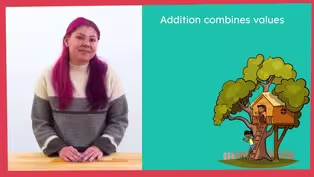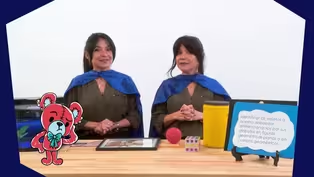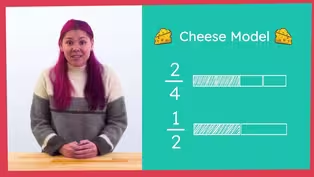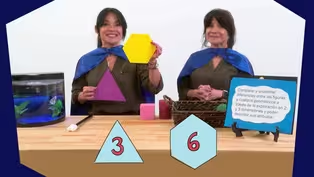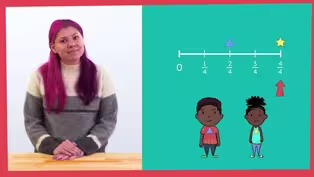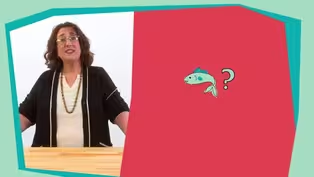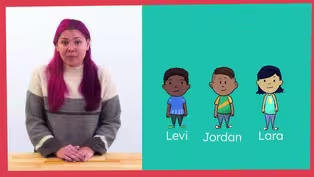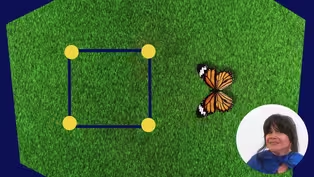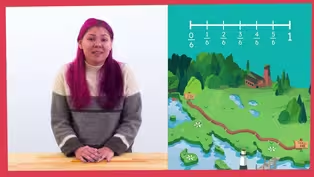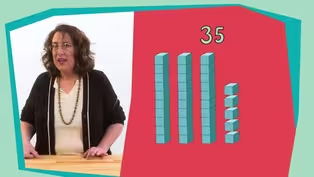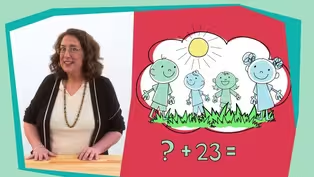
Episode 33 | Math Lessons
4/26/2021 | 28m 46sVideo has Closed Captions
Math lessons for early learners, led by NC teachers.
The first lesson (aimed at PreK-K learners) teaches learners how to compose and decompose numbers in different ways. The second lesson (aimed at 1st-2nd graders) shows students how to solve problems where the result is not known. Classroom Connection is your At-Home Learning companion where children love to learn. All lessons are led by NC educators.
Problems playing video? | Closed Captioning Feedback
Problems playing video? | Closed Captioning Feedback
At-Home Learning Presents: Classroom Connection is a local public television program presented by PBS NC

Episode 33 | Math Lessons
4/26/2021 | 28m 46sVideo has Closed Captions
The first lesson (aimed at PreK-K learners) teaches learners how to compose and decompose numbers in different ways. The second lesson (aimed at 1st-2nd graders) shows students how to solve problems where the result is not known. Classroom Connection is your At-Home Learning companion where children love to learn. All lessons are led by NC educators.
Problems playing video? | Closed Captioning Feedback
How to Watch At-Home Learning Presents: Classroom Connection
At-Home Learning Presents: Classroom Connection is available to stream on pbs.org and the free PBS App, available on iPhone, Apple TV, Android TV, Android smartphones, Amazon Fire TV, Amazon Fire Tablet, Roku, Samsung Smart TV, and Vizio.
Providing Support for PBS.org
Learn Moreabout PBS online sponsorshipMore from This Collection
Math lessons for early learners, led by NC teachers.
Video has Closed Captions
Math lessons for early learners, led by NC teachers. (28m 46s)
Video has Closed Captions
Math lessons for early learners, led by NC teachers. (28m 46s)
Video has Closed Captions
Math lessons for early learners, led by NC teachers. (28m 46s)
Video has Closed Captions
Math lessons for early learners, led by NC teachers. (28m 46s)
Video has Closed Captions
Math lessons for early learners, led by NC teachers. (28m 46s)
Video has Closed Captions
Math lessons for early learners, led by NC teachers. (28m 46s)
Video has Closed Captions
Math lessons for early learners, led by NC teachers. (28m 46s)
Video has Closed Captions
Math lessons for early learners, led by NC teachers. (28m 46s)
Video has Closed Captions
Math lessons for early learners, led by NC teachers. (28m 45s)
Video has Closed Captions
Math lessons for early learners, led by NC teachers. (28m 46s)
Video has Closed Captions
Math lessons for early learners, led by NC teachers. (28m 45s)
Video has Closed Captions
Math lessons for early learners, led by NC teachers. (28m 46s)
Providing Support for PBS.org
Learn Moreabout PBS online sponsorship[cheerful upbeat music] ♪ - Hi, super learners, and welcome to my classroom.
I'm your host, Mr. R, and I am so excited to hang with you today.
We're gonna have a really fun time together, and we're gonna learn at the same time.
You ready?
- Hello, super learners, I'm Ms. L, and I am so glad you're joining me.
Are you ready for a math mission today?
Well, let's get started with a song.
♪ Hello, super learners, how are you ♪ ♪ Hello, super learners, how are you ♪ ♪ I'm so glad you're here today ♪ ♪ And I hope you feel the same ♪ ♪ Hello, super learners, how are you ♪ I feel great today, and I really hope you do too.
I'm so glad you're here.
Now, let's do some math power warmups counting to 20.
Are you ready?
Here we go.
♪ One, two three, four, five six, seven, eight, ♪ ♪ Nine 10, ♪ ♪ 11, 12 ♪ ♪ 13, 14, 15 ♪ ♪ 16, 17, 18 ♪ ♪ 19, 20 ♪ ♪ That was fun ♪ Let's count up to 20 just one more time.
But this time I think we should snap count, ready?
One, two, three, [snaps] four, five, six, [snaps] seven, eight, nine, [snaps] 10.
Let's keep going.
11, 12, 13, 14, 15, 16, 17, 18, 19, 20.
Yes, super learners are the best.
Yes, you are.
I am getting so warmed up.
Are you?
Well, how about one more counting to 20, but this time we'll do it in Spanish.
[speaks Spanish] We made it to 20!
We have counted to 20 three different ways.
Now let's review our colors.
Let's say them in English and in Spanish, ready?
[speaks Spanish] Red, [speaks Spanish] Orange, [speaks Spanish] Yellow, [speaks Spanish] Green, [speaks Spanish] Blue, [speaks Spanish] Purple, [speaks Spanish] Brown, [speaks Spanish] Black, [speaks Spanish] White, and [speaks Spanish] Gray.
Look for these colors in the world today.
All right, super learners, we have one more warmup.
Let's play the shapes game.
You see the shape, and then you say its name in English or in Spanish.
Here we go.
[speaks Spanish] Square, [speaks Spanish] Circle, [speaks Spanish] Triangle, [speaks Spanish] Rectangle, [speaks Spanish] Rhombus, [speaks Spanish] Trapezoid, [speaks Spanish] Hexagon, [speaks Spanish] Cube, [speaks Spanish] Cone, [speaks Spanish] Cylinder, [speaks Spanish] Sphere.
Are you all warmed up now?
Great, then it's time for our math mission of the day, yes!
All right, let's check with Sparkles the fish to see what our mission is today.
Hi, Sparkles, what do you have for us?
Ooh, a special math mission.
All right, Let's read what Sparkles has.
[gasps] Oh, my goodness!
You know what it says?
It says, "Dear super learners.
Your mission today is to show numbers in different ways.
You'll be working with numbers 11 to 19 as a group of 10 and 1s."
Wow, well, super learners.
I really think we can do this.
I know we can actually.
So let's get on our capes and then we can math power up.
Let me get my cape.
I love my super cape, ah.
I feel like I can do any math mission in this cape.
Do you have yours on?
Are you ready?
All right, let's go.
Math power up.
All right [gasps] oh, my goodness, super learners.
Look at what we have today, but also look.
This is our special math tool today.
This is our 10 frame.
It's a block of 10 blocks.
So let's count them.
I heard that there's 10 blocks, but I want to make sure.
I always like to count first.
So let's see.
We have, one, two, three, four, five, Okay, five on top, all right.
Let's see.
Six, seven, eight, nine, 10.
Okay, there's 10.
So five on the top and five on the bottom.
10 blocks in our 10 frame.
This will help us quickly count to see how many blocks are filled and how many are empty while we're doing our mission today.
And we'll see just really how helpful this tool is.
So let's get started.
I think our first challenge is right in front of us.
It looks like a mess.
It could get tricky, but I think we can do it.
It looks like all of these sports balls have fallen.
Will you help me organize them?
Do you think you can?
Yes, great, thank you, super learners.
All right, so I think we should get started with our soccer balls.
I see we have footballs and soccer balls.
And look, we're supposed to have 11 soccer balls.
So we need to make sure whenever there's a mess like this, we need to count to make sure they're all there, right?
All right, so we'll put this right here.
As a reminder, we have 11 soccer balls.
So we know that if we fill all of these squares, we will have 10 soccer balls at least, but we need 11.
So let's start by filling these squares with our soccer balls, okay?
We'll start with number one.
And then we have number two.
Next we have three.
Then we have four and five.
All right, so we have five on top, and we know if we have five more on the bottom, that's 10.
Okay, so we have five.
Now we have six.
Now we have seven, and then eight.
Eight, okay.
Nine, and 10.
Oh, super learners, we filled up our 10 frame.
Okay, we have 10, but look.
We do have one more.
So I wonder what that equals.
10 and one, 10 and one equals?
11, that's right, perfect.
We have all of our soccer balls.
So 10, 11, all 11 are here.
Awesome job, super learners.
So for challenge number two, we need to organize all of these footballs.
They're supposed to be, let's see.
Oh, this says there are supposed to be 15 footballs.
So I think we can use our 10 frame again to help us count how many footballs there are.
So let's see, we'll put this here as a reminder.
And we know that if we fill all of these squares, we have 10 footballs.
So let's start and see if we at least have 10 here today.
Okay, can you help me?
Awesome, super learners, let's go.
All right, we have one.
We have two.
we have three footballs.
We have four and five.
All right, we have our first row filled.
We at least have five footballs.
All right, let's keep counting.
Now we have six and seven.
We have eight nine and 10.
All right, so we at least have 10 footballs.
Our frame is filled, but there's some ones left over.
Wonder what we should do.
You know what, I think we can put them in a line underneath the 10 frame, and we'll do a row of five like the 10 frame does.
Okay, ready?
Let's line them up.
We'll put one here.
Do two, do three.
Move our sign down so we have some room.
Beep, beep.
And we have four and then five.
Wow, okay, we have 10 footballs and then five more.
I wonder how many we have now.
We have our base 10 filled, and then five more.
Let's think, help me think.
We know we have 10.
So let's just keep counting from 10.
How about that, okay.
So we have 10, 11, 12, 13, 14, 15.
We have 15 footballs, super learners.
Yes, great work.
We have all of our sports balls.
My goodness, that was fun.
And I couldn't have done it without you, but we have to check back with Sparkles to see if we've completed the mission, all right?
Hey, Sparkles.
What do you have for us?
[gasps] Yes, congratulations, super learners.
Look, it says mission complete.
You used your math powers and completed the mission.
So what is it time to do?
Review, review.
We always review our work, right?
So let's think.
Today, we built some pretty big numbers.
And now we know how to build numbers with the help of our trusty 10 frame.
So you know what?
You can practice counting and building numbers today.
You can share your math power by showing it to someone.
So I really wanna thank you super learners for going on this math mission with me today.
And also, we've got to thank Sparkles.
Thanks, Sparkles, for your help.
Remember that you have the power to be super at math.
Adios, friends, bye.
- Wow, what a day so far.
So much great learning going on.
Next, we're gonna watch a video about North Carolina that I know you'll love.
- [Narrator] Do you ever wonder what North Carolina looked like before the land was colonized?
This land is a traditional territory of several different native and indigenous people.
The Cherokee, Waccamaw, Saponi, Tuscarora, Catawba, Meherrin, Keyauwee, Pamlico, Sugaree, Waxhaw, Wateree, Chowan, Cheraw, Hatteras, Coree, Shakori, Eno, Sissipahaw, Weaporneoc, Occaneechi, Tutelo, Moratok, Secotan, and Machapunga.
But the story doesn't end there.
Since the inception of these native lands, they have transcended into eight state-recognized tribes that are still here today.
The Coharie, the Eastern Band of the Cherokee Nation, the Haliwa-Saponi, the Lumbee, Meherrin, Occaneechi Band of the Saponi Nation, Sappony, and the Waccamaw Siouan tribe.
We acknowledged the history of this land and our responsibility to honor, protect, and sustain it.
- Hi everybody, my name is Kat.
I'm one of the aviculturists here at Sylvan Heights Bird Park.
And today we're gonna be talking about something a little different.
You can tell, I'm not holding a bird.
I am holding a reptile.
This little guy is known as a kingsnake.
Now these guys are native here to North Carolina, and there are 37 species of snakes found in the state of North Carolina.
So this little guy is one of them.
And this one is very young.
So when he's done growing, he'll be about six feet long.
Now, to give you a perspective on that, I'm about five foot six.
So about six inches from me if you stretch them out long-ways like that.
Snakes in general, they do, unfortunately, have a really bad reputation of being really scary animals, slimy animals, and just overall people are often scared of them.
But they're actually really important for our ecosystem.
That's why snakes are really cool.
If we did not have snakes around the world, there would be a lot of other animals that we would consider pests around here, such as mice.
Snakes, including the kingsnake, love eating mice.
And so they're really good as natural pest control.
And that for some of the other myths about snakes, a lot of people, like I said, they kind of think of them as slimy animals.
That is simply not true.
Snakes are, of course, part of the reptile family, and the defining characteristic of what makes a reptile is that their body is covered in scales, and snakes are definitely covered in that all around their body.
So one of the other things that people often find as like kind of uneasy about snakes, it's their lack of legs.
So they use their belly scales with specialized muscles to help them move around the ground and anything that they can grab friction on such as trees or wood, or, as he's doing right now, going all over in my hand right here.
Now, snakes are all predators.
As I said, many of them hunt mice and other animals such as that.
And they use their tongue to locate them.
They do not have a nose in the sense that we think of it.
They actually use their tongue to sniff out their foods.
So that's why when you see a snake putting their tongue out, like he's doing right now, he is actively sniffing out things in his environment.
They are essentially licking up a smell particles that are in the air around them.
And that tells their brain where the food might be.
So they can follow a trail if they sense something like a mouse or frog.
Now going back to the kingsnakes.
Specifically, these guys are especially good to have around because it ties into why they're called the kingsnake.
They are immune to venom that other venomous snakes have, such as the copperhead and the diamondback rattler.
Those are just two examples of venomous snakes found here in North Carolina.
And the kingsnake is immune to their venom because he will actually eat other venomous snakes, such as the copperhead.
So if you do see a kingsnake around, chances are you're not gonna see any venomous ones around.
Because a lot of people do have an unfortunate fear of them.
And it's understandable.
We're trying to dispel some of those fears.
So if you do see a snake within the vicinity, the best course of action is to not do anything at all.
Just leave the snake alone, just step away.
If he's in your yard, just step back inside the house or whatever you feel comfortable doing.
Because he's just in the area, and he's probably just passing through.
He does not pose a threat to you as long as you do not threaten him.
They are more afraid of you than you are of the snake.
All right, so that concludes today's keeper talk.
I hope you guys had fun learning about snakes, 'cause they are such really cool animals.
I'll see you next time.
- Did y'all like that?
That was so cool.
Thank goodness for this time right at home.
Look, can't stop now.
Check out what we got next.
- Hi friends, My name is Dawn, and I am so happy to be here with you today.
This is my friend Splat, and he is going to help me today with some math fun.
He and I are so excited to do some fun math with you.
Are you ready?
Before we get started, let's take some time to get some supplies.
You might want to get something to write with, some paper or whiteboard, and a stuffed animal or trusted adult to talk to.
I'll wait right here while you to get what you need.
[upbeat music] Welcome back, let's get started.
Today, we are going to solve a problem about one of my favorite foods, apples.
I love to eat them.
I have another friend named Moesha who also loves apples.
She loves them so much that she collects them on her table.
Here's a picture of Moesha's apples.
Talk to a friend about what you notice about the apples.
Splat notices that there are red and green apples.
Today, we're going to read a mathematical story about Moesha and some apples that she has collected on her table.
Before we get started, let's exercise our brain and get it ready to do some math work so we can be fit mathematicians.
Will you join me?
Let's get on our feet, and let's do two arm circles.
One, two.
Nice job.
Now let's do three more arm circles.
One, two, three.
Awesome, so we started with two arm circles, and then we did three more.
So how many did we do all together?
Right, five.
Because two arm circles plus three arm circles equals five.
Now, let's stay on our feet and do four hops.
Are you ready?
One, two, three, four.
Nice job.
Now let's do three more hops.
One, two, three.
Awesome, so we started with four hops, and then we did three more hops.
So we did seven hops altogether, because three plus four equals seven.
Wow, I feel energized and ready to focus on helping Moesha figure out how many apples she has.
Your job today is to figure out how many apples Moesha has on her table.
So let's read a little bit to find out about Moesha and her apples.
Moesha has some red apples and some green apples on the table.
What are you picturing in your mind, hmm?
I'm picturing Moesha with red apples and green apples on her table.
How many red apples do you think Moesha has?
Right, she could have 12 or seven or even 20 red apples.
Now tell someone or your stuffed animal, how many green apples could Moesha have.
Moesha could have five, three, or even 99 green apples.
Let's read a little more about Moesha.
Moesha has 14 red apples and some green apples on the table.
What do we know now that we didn't know before?
That's right.
We now know that Moesha has 14 red apples.
Let's keep reading.
Moesha has 14 red apples and six green apples on the table.
What do we know?
What do we find out now that we didn't know before?
You are so right.
We now know that Moesha has six green apples.
What question could we ask about this math story?
Let's think of a question about Moesha and her apples, and share your question with a trusted adult or friend, and then whisper it to Mr. Splat and me.
Okay, I'm listening.
Let me listen in for the whispers.
Cool, I hear a whisper that says we could ask how many more red apples than green apples does Moesha have.
That's a great question.
Splat says that we can ask, "How many apples does Moesha have on the table?"
Let's read a little more about Moesha.
Moesha has 14 red apples and six green apples on the table.
How many apples does she have on the table in all?
What is the question in this story?
Yes, you are right.
The question is asking the total amount of green and red apples Moesha has on the table.
Do you think you have all the information you need to answer that question?
You're right.
You do have all the information you need.
I want you to think about how you could solve this problem.
Tell a trusted adult or friend how you would solve this problem.
Splat always helps me solve math stories.
Splat just told me a way that I can solve this problem.
Splat says we can use a tool called a 10 frame.
Let's try it out.
We can use two 10 frames to find how many apples Moesha has on her table.
We are going to use the red counter for the red apples and the green counter for the green apples.
Moesha had 14 red apples.
I'm going to put 14 counters on the 10 frames.
I know that when I fill one up, I have used 10 counters.
Watch as I count the 14 red counters on to the 10 frames.
One, two, three, four, five, six, seven, eight, nine, 10.
I have filled up one 10 frame.
Help me count the rest of the counters as I put them on the other 10 frame, ready?
This is 11, 12, 13, 14.
All 14 apples are represented in the 10 frames.
Now let's put six green apples using the green counters on the 10 frame.
I'm going to start putting the green counters on the same row I left off with the red counters.
Count with me.
One, two, three, four, five, six.
We put 14 red counters and six green counters on the 10 frames.
Tell a friend what you notice.
Awesome, I noticed the same.
Both 10 frames are filled up.
That means that Moesha has 20 apples altogether.
When both 10 frames are filled up it means I have two groups of 10 which has the same value as 20.
We figured out that Moesha has 20 apples.
Awesome, friends.
Let's take a brain break and exercise our numbers, counting down from 10 for inspiration.
Are you ready to move your body to each number?
Let's go.
Let's do 10 twists.
One, two, three, four, five, six, seven, eight, nine, 10.
Let's do nine hops.
One, two, three, four, five, six, seven, eight, nine.
Good job.
Let's do eight arm circles.
One, two, three, four, five, six, seven, eight.
Next let's do seven knee bends.
One, two, three, four, five, six, seven.
Good job.
Let's do six arm stretches.
One, two, three, four, five, six.
Let's do five knee raises.
One, two, three, four, five.
Next let's do four side bends.
One, two, three, four.
Ooh, let's do the toe raises.
One, two, three.
Two head nods.
One, two.
And finally one big jump.
One.
Wooh, that was fun exercising our math minds by counting down from 10.
Now that we've moved some, we can think of another way to solve this problem.
Remember that our problem is that Moesha has 14 red apples and six green apples.
How many does she have altogether?
Take some time to solve this another way, and then show Splat and me.
[upbeat music] I see some great strategies to solve this problem.
Another way Splat says would be to draw a picture.
Yes, let's draw a picture.
Let's draw a picture of 14 red apples.
Now let's add Moesha's six green apples.
Next, count up all of her apples.
Yes, we have 20.
An equation we could write to the story would be 14 plus six equals 20.
That is some great thinking about math and different strategies for solving addition problems.
Friends, you did such a great job of solving the mathematical story of how many apples Moesha has altogether.
We used 10 frames and pictures to solve that Moesha has 20 apples altogether.
Splat and I would love to hear you say what you learned today.
I have these two sentence starters to help us talk about what we learned.
They say, "Today I learned, and I can."
So I might say, Today, I learned how to solve addition problems.
I can solve addition problems using 10 frames and by drawing pictures.
Now it's your turn.
Today I learned.
Okay, our next sentence.
I can.
I heard some great answers.
Great job talking about your math learning.
You worked so hard today.
Friends, Splat and I have to go now.
You did a great job using addition strategies to solve story problems.
Splat and I hope you enjoy today and we hope to see you soon.
[frame bloops] [air whooshes] - That was awesome.
My good people, we learned a lot, and I'm sure that your brain is getting bigger and stronger every day.
Learning is so important.
Without it, you could never get better at things, like running, reading, making up stories.
Without learning, we'd be the same person every day, and we'd never grow up.
[cheerful upbeat music] ♪


- Home and How To

Hit the road in a classic car for a tour through Great Britain with two antiques experts.












Support for PBS provided by:
At-Home Learning Presents: Classroom Connection is a local public television program presented by PBS NC
